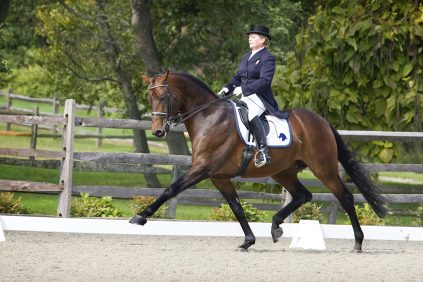Yesterday I was hacking my 4-year-old gelding, Deep Woods, and I couldn’t stop thinking how wonderful he is. The weather has been awful here in Illinois so all the horses have been stuck inside for the past few days. We’d all been gone at a clinic over the weekend, so the horses that stayed home hadn’t been ridden. Woody, as he’s affectionately known, had every reason to misbehave, but he flatted around like an old schoolmaster.
Don’t worry, this isn’t a shameless advertising plug; I’ve just been thinking recently about how fortunate I am to have horses that are safe, honest, and talented. Not all the horses that come to me for training have been such reliable characters. Over the years I’ve worked with many horses that came with adjectives like “tough,” “extremely sensitive,” “asshole,” and “ruined.”
Often, I have been their last resort. They don’t want to jump, they run away, they buck and rear, the list of offenses goes on and on, but one factor is constant: one person or many people have made them this way. One in 5,000 horses comes out of the womb unwilling and dangerous. The rest of these “problem horses,” as they’ve been called, have been ruined by us.
There are innumerable factors that all contributed to the development of these horses’ undesirable behaviors. I could blame one person or I could blame every person who’s had anything to do with these horses. The blame would be justified in either scenario, and pointless in both scenarios. The fact of the matter is that these are ruined animals and we have failed them.
Every ruined horse has a root; in most cases their problems did not spring up overnight but grew day by day. And sadly in some cases, the solutions people have tried are the same: they beat them, bitted them, exhausted them, and then sent them to the next trainer in line, where the same process happened all over again.
These ruined horses tell me we need to do better. We as a sport, an industry, and a culture need to do better. I include myself in this statement. I could list for you all the instances where I made poor decisions, either out of lack of knowledge, patience, or thoughtful consideration, and the horse had to live with my mistakes. I live with them too, though. I make sure I remember those times when I could have been better so that I do better.
ADVERTISEMENT
I will be the first to stand up for the amazing talent we have in this country. Every day I am met with kind, devoted people who have made horses their life’s work, and they are striving and thriving in that work. I know we can be brilliant, which is why I know we can do better. If we fail to be excellent in our work, our horses will fail. If we put traditional dogma and social pressure ahead of horsemanship and education, we will have more and more ruined animals. If we continue to privilege those who contribute the highest profits to our industry over those who contribute the highest quality horses and riders, our sport will suffer. If we consistently keep ignoring the accumulated wisdom of horsemen from all different walks of life because it’s unfamiliar to us, the great community and culture of hunters and jumpers will continue to shrink in scope and diversity.
We all need to do better.
Often the problem horses I see have tremendous talent, and therefore tremendous potential monetary value. Because so much money and success are at stake, trainers feel pressured to “make it work” at any cost. This horse is very spooky but needs to jump around at a show next week. The horse must be quiet enough for the hunter ring. The horse needs to be sold but it’s a stopper. The horse has so much talent but it simply won’t behave. The client spent a ton of money on the horse only to find it’s not a good match. “Make it work, no matter what,” seems to be the mantra.
It has become acceptable to tell our horses that if they will not do, they will suffer. Getting someone to complete tasks for you because you put a gun to their head is not teaching, just as getting a horse to perform for you because you have coerced it is not training. It works, yes, but do we really just want to make it work? Have we given up on excellence in our instruction?
In order to stop creating problem horses, at each stage, we—the breeder, the owner, the handler, the starter, the trainer, and the show rider—need to strive to do better for our horses. I fall in every category listed above and you’d better believe it is daunting to have the burden of excellence spread across so many specialties. But the horse will keep me and inspire me. I think that’s the key to doing better; if we see the horse, the actual living, thinking individual in front of us, instead of the money it’s worth, the job it must do, or the people who see it as a collection of resources to be mined, I think we will do better. I know I will.
Rebecca Young works for Everbold Farm in Kirkland, Ill. She rides, trains, shows and breeds primarily jumpers but does not discriminate against the occasional hunter. When not on horseback, Rebecca takes great joy in hiking, skiing, mountaineering,














